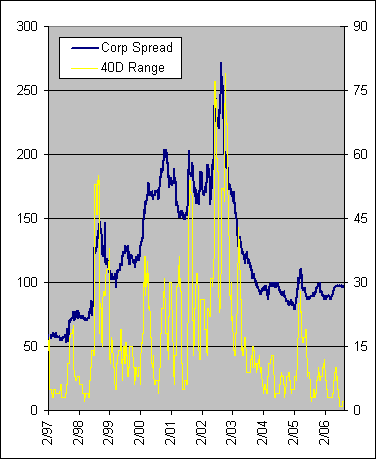Despite the much ballyhooed fears of corporate bond spreads widening, spreads have been extremely stable in 2006? How stable you ask? Look at the following chart.
The blue line is the OAS for the Merrill Lynch Corporate Master. The yellow line is the 20 day range of the same OAS. So if the widest spread in a 20 trading day period is 90bps and the tightest is 70bps, then range is 20bps. Simple right? I have about 10-years worth of data, which is as much as Merrill Lynch publishes on OAS.
The range over the last 20 days is extremely low: 2bps. So if you had a crystal ball and knew exactly what day was going to have the widest spread and what day would have the tightest, you'd still have a hard time making much money trading the corporate basis.
I'm not sure what to make of this. We don't really have that much data to work with to draw much statistical conclusion. Although it looks like there is a strong correlation between the range and the spread, it looks like that is dominated by the periods of extreme widening. Its simple arithmetic to see that if spreads spike higher the range will get wider. We don't have an example of spreads moving 100bps higher and hanging there.
What that could mean is that there is more of a floor to corporate spreads than there is a ceiling. By this I mean, a corporate bond spread that starts at +100 vs. Treasuries can't go to zero, but can go to +1,000. Investors need to see a certain yield concession to own corporates period, and yield spreads cannot fall beyond this point. So even when corporate fundamentals are very strong, spreads can only tighten so much.
So if that idea is right, and we're in a period where corporate fundamentals are strong but we observe an unwillingness on the part of marketeers to bid up corporates, then maybe we've already hit that floor. This means there is little upside to corporate bonds, and at best you'll collect the extra yield.
So normally we'd expect corporate spreads to tighten as the curve steepens, but it might be different this time.
Monday, October 16, 2006
Groundhog Day in Corporate Spreads
Subscribe to:
Post Comments (Atom)



No comments:
Post a Comment